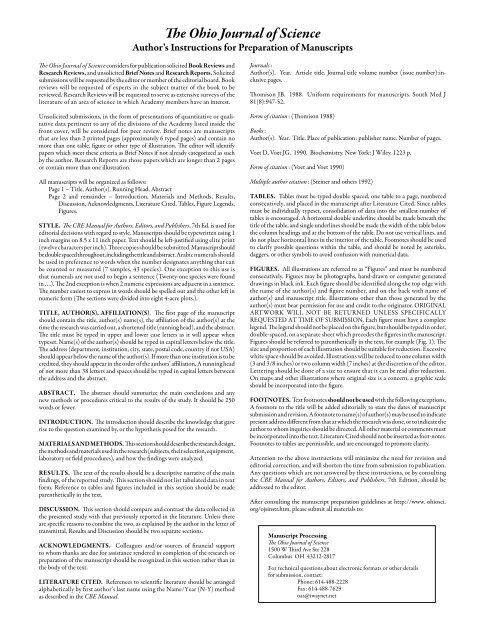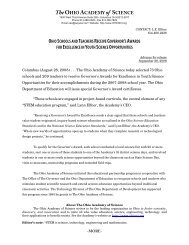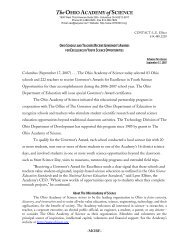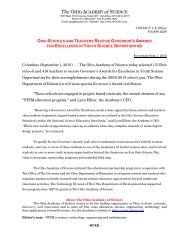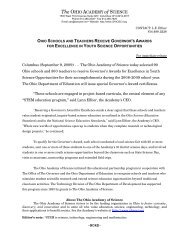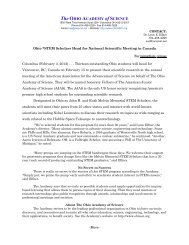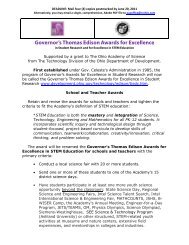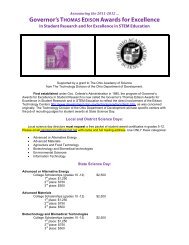The Ohio Journal of - The Ohio Academy of Science
The Ohio Journal of - The Ohio Academy of Science
The Ohio Journal of - The Ohio Academy of Science
You also want an ePaper? Increase the reach of your titles
YUMPU automatically turns print PDFs into web optimized ePapers that Google loves.
172 RUNNING HEAD<br />
<strong>The</strong> <strong>Ohio</strong> <strong>Journal</strong> <strong>of</strong> <strong>Science</strong><br />
Author’s Instructions for Preparation <strong>of</strong> Manuscripts<br />
Vol. 97<br />
<strong>The</strong> <strong>Ohio</strong> <strong>Journal</strong> <strong>of</strong> <strong>Science</strong> considers for publication solicited Book Reviews and<br />
Research Reviews, and unsolicited Brief Notes and Research Reports. Solicited<br />
submissions will be requested by the editor or member <strong>of</strong> the editorial board. Book<br />
reviews will be requested <strong>of</strong> experts in the subject matter <strong>of</strong> the book to be<br />
reviewed. Research Reviews will be requested to serve as extensive surveys <strong>of</strong> the<br />
literature <strong>of</strong> an area <strong>of</strong> science in which <strong>Academy</strong> members have an interest.<br />
Unsolicited submissions, in the form <strong>of</strong> presentations <strong>of</strong> quantitative or qualitative<br />
data pertinent to any <strong>of</strong> the divisions <strong>of</strong> the <strong>Academy</strong> listed inside the<br />
front cover, will be considered for peer review. Brief notes are manuscripts<br />
that are less than 2 printed pages (approximately 6 typed pages) and contain no<br />
more than one table, figure or other type <strong>of</strong> illustration. <strong>The</strong> editor will identify<br />
papers which meet these criteria as Brief Notes if not already categorized as such<br />
by the author. Research Reports are those papers which are longer than 2 pages<br />
or contain more than one illustration.<br />
All manuscripts will be organized as follows:<br />
Page 1 – Title, Author(s), Running Head, Abstract<br />
Page 2 and remainder – Introduction, Materials and Methods, Results,<br />
Discussion, Acknowledgments, Literature Cited, Tables, Figure Legends,<br />
Figures.<br />
STYLE. <strong>The</strong> CBE Manual for Authors, Editors, and Publishers, 7th Ed. is used for<br />
editorial decisions with regard to style. Manuscripts should be typewritten using 1<br />
inch margins on 8.5 x 11 inch paper. Text should be left-justified using elite print<br />
(twelve characters per inch). Three copies should be submitted. Manuscript should<br />
be double spaced throughout, including the title and abstract. Arabic numerals should<br />
be used in preference to words when the number designates anything that can<br />
be counted or measured (7 samples, 43 species). One exception to this use is<br />
that numerals are not used to begin a sentence (Twenty-one species were found<br />
in . . .). <strong>The</strong> 2nd exception is when 2 numeric expressions are adjacent in a sentence.<br />
<strong>The</strong> number easiest to express in words should be spelled out and the other left in<br />
numeric form (<strong>The</strong> sections were divided into eight 4-acre plots.).<br />
TITLE, AUTHOR(S), AFFILIATION(S). <strong>The</strong> first page <strong>of</strong> the manuscript<br />
should contain the title, author(s) name(s), the affiliation <strong>of</strong> the author(s) at the<br />
time the research was carried out, a shortened title (running head), and the abstract.<br />
<strong>The</strong> title must be typed in upper and lower case letters as it will appear when<br />
typeset. Name(s) <strong>of</strong> the author(s) should be typed in capital letters below the title.<br />
<strong>The</strong> address (department, institution, city, state, postal code, country if not USA)<br />
should appear below the name <strong>of</strong> the author(s). If more than one institution is to be<br />
credited, they should appear in the order <strong>of</strong> the authors’ affiliation. A running head<br />
<strong>of</strong> not more than 38 letters and spaces should be typed in capital letters between<br />
the address and the abstract.<br />
ABSTRACT. <strong>The</strong> abstract should summarize the main conclusions and any<br />
new methods or procedures critical to the results <strong>of</strong> the study. It should be 250<br />
words or fewer.<br />
INTRODUCTION. <strong>The</strong> introduction should describe the knowledge that gave<br />
rise to the question examined by, or the hypothesis posed for the research.<br />
MATERIALS AND METHODS. This section should describe the research design,<br />
the methods and materials used in the research (subjects, their selection, equipment,<br />
laboratory or field procedures), and how the findings were analyzed.<br />
RESULTS. <strong>The</strong> text <strong>of</strong> the results should be a descriptive narrative <strong>of</strong> the main<br />
findings, <strong>of</strong> the reported study. This section should not list tabulated data in text<br />
form. Reference to tables and figures included in this section should be made<br />
parenthetically in the text.<br />
DISCUSSION. This section should compare and contrast the data collected in<br />
the presented study with that previously reported in the literature. Unless there<br />
are specific reasons to combine the two, as explained by the author in the letter <strong>of</strong><br />
transmittal, Results and Discussion should be two separate sections.<br />
ACKNOWLEDGMENTS. Colleagues and/or sources <strong>of</strong> financial support<br />
to whom thanks are due for assistance rendered in completion <strong>of</strong> the research or<br />
preparation <strong>of</strong> the manuscript should be recognized in this section rather than in<br />
the body <strong>of</strong> the text.<br />
LITERATURE CITED. References to scientific literature should be arranged<br />
alphabetically by first author’s last name using the Name/Year (N-Y) method<br />
as described in the CBE Manual.<br />
<strong>Journal</strong>s :<br />
Author(s). Year. Article title. <strong>Journal</strong> title volume number (issue number):inclusive<br />
pages.<br />
Thomison JB. 1988. Uniform requirements for manuscripts. South Med J<br />
81(8):947-52.<br />
Form <strong>of</strong> citation : (Thomison 1988)<br />
Books :<br />
Author(s). Year. Title. Place <strong>of</strong> publication: publisher name. Number <strong>of</strong> pages.<br />
Voet D, Voet JG. 1990. Biochemistry. New York: J Wiley. 1223 p.<br />
Form <strong>of</strong> citation : (Voet and Voet 1990)<br />
Multiple author citation : (Steiner and others 1992)<br />
TABLES. Tables must be typed double spaced, one table to a page, numbered<br />
consecutively, and placed in the manuscript after Literature Cited. Since tables<br />
must be individually typeset, consolidation <strong>of</strong> data into the smallest number <strong>of</strong><br />
tables is encouraged. A horizontal double underline should be made beneath the<br />
title <strong>of</strong> the table, and single underlines should be made the width <strong>of</strong> the table below<br />
the column headings and at the bottom <strong>of</strong> the table. Do not use vertical lines, and<br />
do not place horizontal lines in the interior <strong>of</strong> the table. Footnotes should be used<br />
to clarify possible questions within the table, and should be noted by asterisks,<br />
daggers, or other symbols to avoid confusion with numerical data.<br />
FIGURES. All illustrations are referred to as “Figures” and must be numbered<br />
consecutively. Figures may be photographs, hand-drawn or computer generated<br />
drawings in black ink. Each figure should be identified along the top edge with<br />
the name <strong>of</strong> the author(s) and figure number, and on the back with name <strong>of</strong><br />
author(s) and manuscript title. Illustrations other than those generated by the<br />
author(s) must bear permission for use and credit to the originator. ORIGINAL<br />
ARTWORK WILL NOT BE RETURNED UNLESS SPECIFICALLY<br />
REQUESTED AT TIME OF SUBMISSION. Each figure must have a complete<br />
legend. <strong>The</strong> legend should not be placed on the figure, but should be typed in order,<br />
double-spaced, on a separate sheet which precedes the figures in the manuscript.<br />
Figures should be referred to parenthetically in the text, for example (Fig. 1). <strong>The</strong><br />
size and proportion <strong>of</strong> each illustration should be suitable for reduction. Excessive<br />
white space should be avoided. Illustrations will be reduced to one column width<br />
(3 and 3/8 inches) or two column width (7 inches) at the discretion <strong>of</strong> the editor.<br />
Lettering should be done <strong>of</strong> a size to ensure that it can be read after reduction.<br />
On maps and other illustrations where original size is a concern, a graphic scale<br />
should be incorporated into the figure.<br />
FOOTNOTES. Text footnotes should not be used with the following exceptions.<br />
A footnote to the title will be added editorially to state the dates <strong>of</strong> manuscript<br />
submission and revision. A footnote to name(s) <strong>of</strong> author(s) may be used to indicate<br />
present address different from that at which the research was done, or to indicate the<br />
author to whom inquiries should be directed. All other material or comments must<br />
be incorporated into the text. Literature Cited should not be inserted as foot-notes.<br />
Footnotes to tables are permissible, and are encouraged to promote clarity.<br />
Attention to the above instructions will minimize the need for revision and<br />
editorial correction, and will shorten the time from submission to publication.<br />
Any questions which are not answered by these instructions, or by consulting<br />
the CBE Manual for Authors, Editors, and Publishers, 7th Edition, should be<br />
addressed to the editor.<br />
After consulting the manuscript preparation guidelines at http://www. ohiosci.<br />
org/ojsinstr.htm, please submit all materials to:<br />
Manuscript Processing<br />
<strong>The</strong> <strong>Ohio</strong> <strong>Journal</strong> <strong>of</strong> <strong>Science</strong><br />
1500 W Third Ave Ste 228<br />
Columbus OH 43212-2817<br />
For technical questions about electronic formats or other details<br />
for submission, contact:<br />
Phone: 614-488-2228<br />
Fax: 614-488-7629<br />
oas@iwaynet.net


